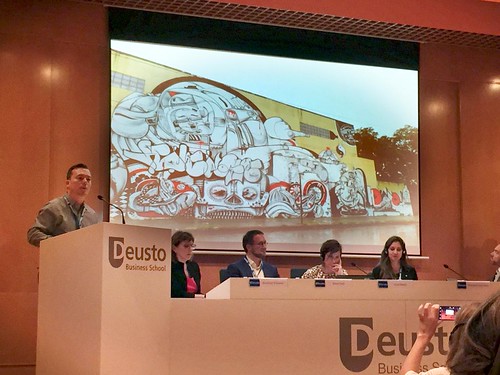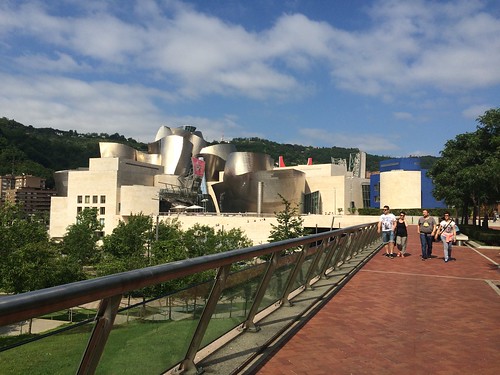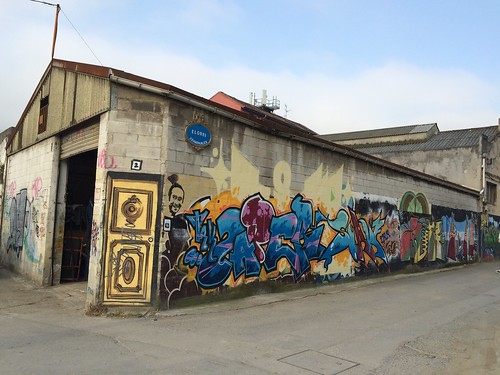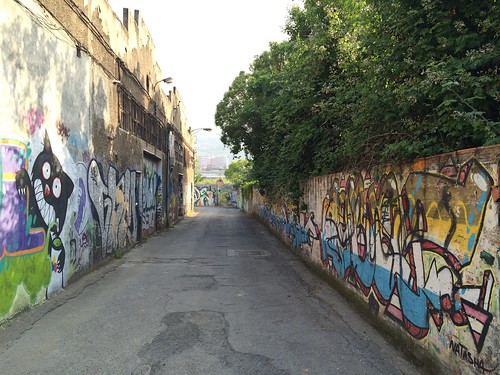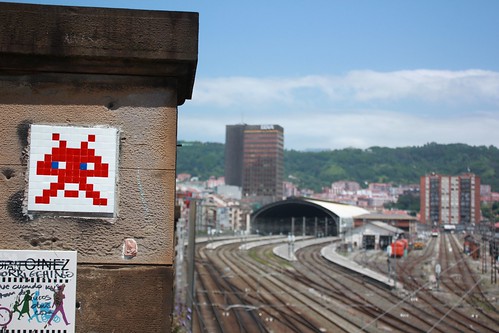So we've come to the end of the road for my essay on
5 Pointz. And as chance would have it, an article about the building's impending demolition has come to my attention. It's called
LIC Parents: Demolish the 5 Pointz Building, Save the Graffiti, and and while the premise behind it is interesting, the tone of the letter is jaw dropping.
On the one hand, it's true that MoMa's high concrete walls would make a great canvas, both for their size and their visibility. So kudos for trying to think of something,
anything that might preserve some of the painting. That said...
Um, don't you think maybe someone might have already thought of this? It's so obvious, how could it not have been brought up? Gee, I wonder why it might not have gone forward? Maybe because, large as the walls are, they're still a teeny tiny space compared to 5 Pointz. It would be like taking away someone's chalk board and handing them a note pad and then expecting them to be happy. Not that the folks from the LIC Parents' group are actually interested in promoting graffiti murals:
"Could there be a better synergy than between MOMA’s high concept art and
mind-numbing street art of the aerosol kind?" (emphasis mine)
Uh yeah,
mind numbing is the first thing that comes to mind when I see things like this:

Seriously, when your hostility to the form is that hard to repress, why even bother pretending you care?
Then there's this:
"They were generous (and a bit clever) by parceling up brittle floors
with drafty windows into artist studios and renting the spaces at rates
that few real businesses would be willing to pay."
Excuse me? Have they never heard of building owners renting out old buildings to artists until they can scrape together enough capital to renovate or replace the building and thus charge more rent? This aspect of 5 Pointz is not new or particularly unique. What is unique is the skin of the building, which I explore in more detail below.
All I can say is this is a depressing example of the ignorance that can be found in many corners the city. When you're in thrall with an art form, it's easy to assume that others dig it too. Alas...
Anyway, on to part III!
And what of the self-appointed curator of 5 Pointz? When asked why a place like 5 Pointz might be important, with its multitude of pieces presented together on nearly every conceivable space, MeresOne speaks not as someone concerned with the overall look; but as a promoter of a culture near and dear to him.
It’s about people, you know? It’s more enjoyable; it’s kind of boring to [paint] alone. It’s not a gang or anything; when they paint, they just get together and do a wall. (From an interview on Dec. 9. 2009)
Speaking with a croak that suggests he’s perhaps spent a few too many days painting without a mask, Meres also joked that one of the reasons why graffiti artists crave outdoor spaces like the walls of 5 Pointz and countless other mural locations over indoor spaces, is it’s better on their lungs. But of course, it’s really just a simple matter of being seen by an audience that’s either large or influential, the latter being other writers and fans of graffiti.
If you’re there, other people will be there, and they may say ‘Wow, there’s a piece where I didn’t expect to see it.’ I’ve done some spots where you’re out in the woods, like along in Jersey, you walk through a park, you ended up behind a factory. (From an interview on Dec. 9. 2009)
MeresOne estimated that 5 Pointz hosts 1,000 different pieces annually, with many writers returning to the space over and over. He didn’t say as much when he cited that number, but I suspect that doesn’t include installations such as one that I witnessed in person—A red and white blocky “Ricoh,” whose outline he painted on the southwest corner of the complex in December 2009.
 |
| Visitors take turn "tagging" the Rico logo |
When I visited the site then, a group of about 25 visitors who’d piled out of a tour bus were taking turns filling in the outlines of the letters with red spray paint, while posing for pictures. “Tagging,” it seems, is something that people will pay for the privilege to do, as MeresOne said they’d compensated him for allowing them to try their hand at the famous 5 Pointz. After they left, he quickly spray painted over it again, creating a space ready for a new, less commercially infected creation.
MeresOne has wrestled with the competing interests of art and commerce, on the one hand trumpeting the validity of graffiti and the importance of 5 Pointz, and then accepting money from groups with no interest in creating art. He is not wrong to take money to support the greater cause of 5 Pointz, (as recently as November 8, 2012, 5 Pointz was featured on the TV show
Project Runway) as he supervises the space for no salary.
When he explains the logic behind taking money from the likes of Ricoh, he pins some blame on Wolkoff’s greediness. This might come across as sour grapes from someone who has enjoyed a free lunch, but it’s worth noting that Wolkoff let the building fall into such disrepair that an outdoor stairwell collapsed in April, 2009, seriously injuring one of the Crane Street Studio’s artists. This lead to the eviction of the studio, and the building has sat largely
empty ever since.
This raises the possibility that Wolkoff allowed 5 Pointz to fall into disrepair, thus making it easier to justify knocking it down and building something radically different in its place. In a sense, it’s a moot point though; the aforementioned rezoning gave an official blessing to the eventual demolition of the building. MeresOne may be living in a world where he has to cater to corporate tourists in order to keep his operation going, but Wolkoff is a developer in a town where, as noted earlier, the demand for housing is astronomical.
When he’s asked about the loss of the tenants of the Crane Street Studios, MeresOne is not terribly moved.
Q: Have things changed much since the closing of the studios inside 5 Pointz?
A: Not really. I don’t have to be as conscious if the radios are as loud outside, now we can turn the music on as loud as we want to. Otherwise it’s the same. There were some hypocrites who were two-faced, they’d say hello and then talk down on us and label us. So at times that would happen.
(From an interview on Dec. 9. 2009)
If MeresOne is a little too caught up in the importance of his art to the exclusion of others, Wolkoff is much too confident that he can incorporate the past into the present. In a New York Times article about the impending demolition, he revealed that the space reserved for the graffiti artists would be a rear wall. This cannot be seen as anything more than a token gesture, akin to a scale model of the original Waldorf-Astoria hotel stored in
the lobby of the Empire State Building.
For the time being, the painting continues unabated, as writers can be seen daily adding layer upon ultrathin layer to the outside of a crumbling leviathan. The future of this state of affairs is in doubt, but even without the aid of architectural renderings of Wolkoff’s planned development, it’s possible to get a sense of say, the year 2016 by standing at the corner of Jackson Avenue and Crane Street and facing west toward the Citicorp Tower. Verticality is key, not spontaneity. Monetary capital will triumph here, as neighborhood cultural capital will be ceded to more trusted keepers at PS 1.
 |
| The past is the foreground; the future is the background. |
For now, the contrast between the squat, crumbling stone building with an ever changing skin and the cool, shimmering tall glass tower just down the street, can be illustrated neatly by Koolhaas’s explanation of the work of architect Hugh Ferriss, who first envisioned New York as the “mega-village.”
Ferriss’ most important contribution to the theory of Manhattan is exactly the creation of an illuminated night inside a cosmic container, the murky Ferrissian Void: A pitch black architectural womb that gives birth to the consecutive stages of the skyscraper in a sequence of sometimes over lapping pregnancies, and that promises ever new ones.
 |
One57, dubbed the "Billionaire's Haven," under construction
in July, 2012 |
It is important to note that this is a New York City where humble buildings such as 5 Pointz are 15 minutes from not only cultural beacons such as Carnegie Hall, but also out of this world havens where 11,000-square-foot duplex apartments now sell for
$95 million. So it is depressingly understandable that Ferriss’ vision of a void that encompasses all of the Manhattan sky, just waiting to be taken over by successive skyscrapers, extends across the East River into Queens, a borough known more for its parkland and polyglot immigrant population than its skyline.
The “Ferrisian void” that will be filled between Crane and Davis Street in Long Island City may not contain the space of business the way its glassy neighbor to the west does, but in the scope of filling the void, and adding bulk to fill in the “cosmic container,” it is no different.
When the wrecking ball finally meets 5 Pointz, and the name, which is an ode to New York City’s five boroughs, is either retired or transferred by MeresOne to some other destination, what replaces it will pail in comparison, if for no other reason than its replacement will sync with the demands of monetary capital and the void will be overwhelmed with space primarily for generating profit. Among the oppositions that will disappear from the scene is change: The morphing, “that wasn’t there last week” quality of the vast canvas that is the exterior will be replaced by something static and predictable.
To expect anything less from residents within would be unrealistic. Wolkoff might truly believe he’s honoring the energy and history of graffiti by providing a space for future artists work, but unless it’s a space that is visible from the elevated 7 train and the myriad passersby in the neighborhood, it won’t be any more appealing to graffiti artists than the dozen or so spaces around the city that are also open to artists in the know.
A corollary might be the punk rock club CBGB, which closed in 2006 and was replaced 18 months later by high-end clothing John Varvatos store, which peddles $250 shirts. Remnants of the original institution remain, but it is an echo from the past, useful for reminiscing perhaps, but not much else.
 |
| A visitor takes in the site. |
